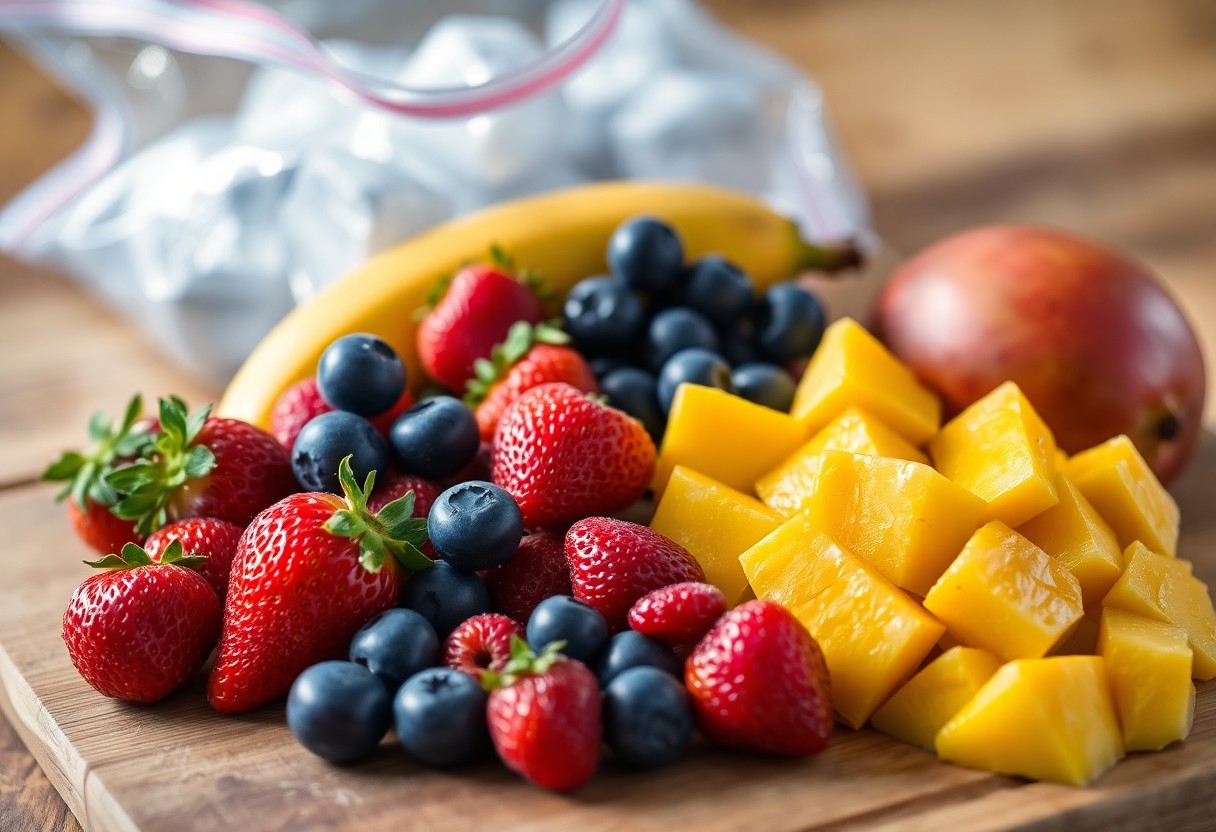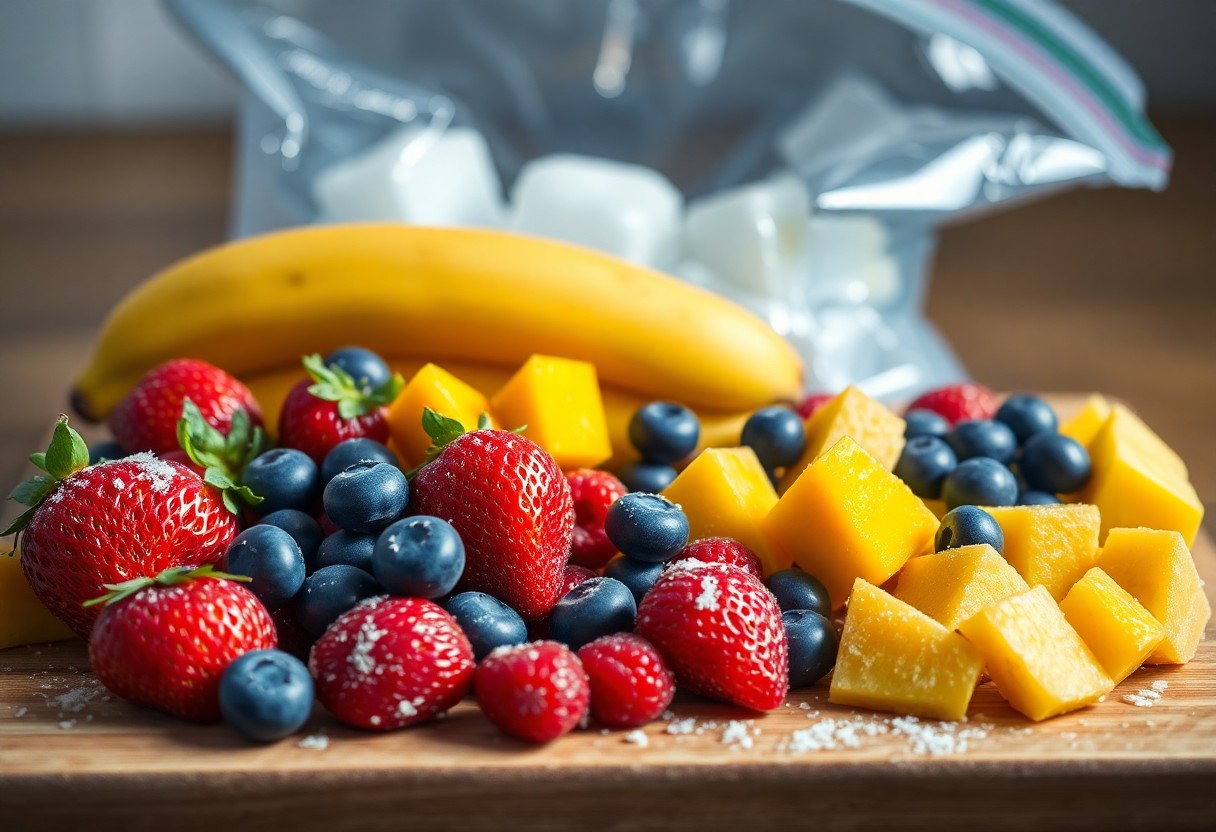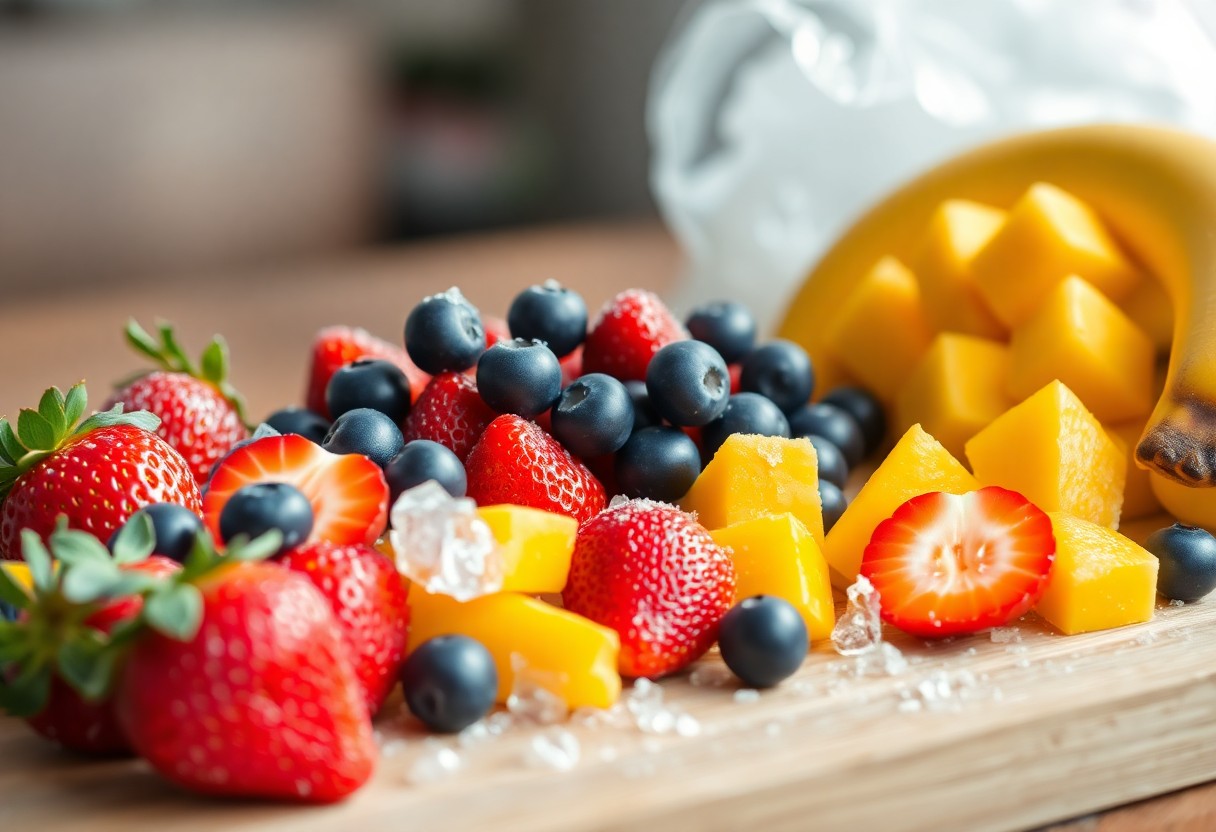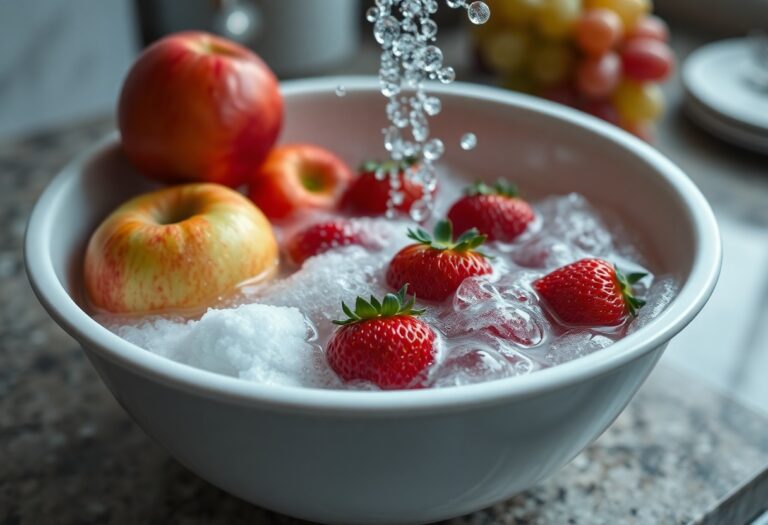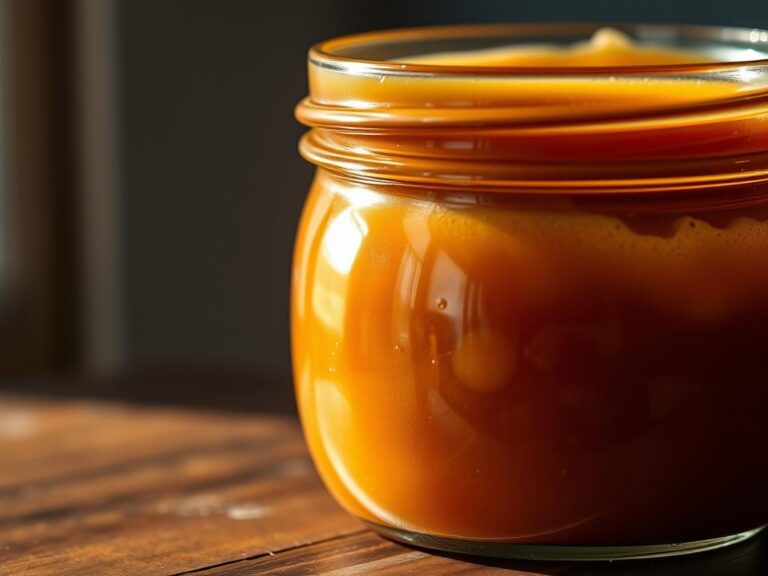how to freeze fruit for smoothies
Just imagine having perfectly frozen fruit ready to blend into your favorite smoothies whenever you want! Freezing fruit is a simple and effective way to preserve its flavor and nutritional value, allowing you to create delicious, refreshing drinks year-round. In this guide, you’ll learn the best methods for freezing various fruits, so you can enjoy the benefits of fresh smoothies even when certain fruits are out of season. Let’s investigate the steps that will make your smoothie prep easier and more convenient.
Selecting the Right Fruits for Freezing
Seasonal and Freshness Considerations
Choosing fruits that are in peak season will significantly enhance the quality of your smoothies. For example, summer months are ideal for berries such as strawberries, blueberries, and raspberries, which are not only at their sweetest but also most nutritious when harvested at their peak. Visiting local farmers’ markets or grocery stores can help you identify what’s in season, allowing you to select vibrant, fully ripened fruits that will freeze beautifully. Consider freezing small batches throughout the season to ensure a steady supply for your smoothies all year round.
When deciding on fruits for freezing, always prioritize freshness. Overripe or bruised fruits not only lose flavor but can also affect the texture of your blended smoothies. Aim for fruits that are firm to the touch and exhibit a rich color, as these indicators generally correlate with higher sugar content and overall taste. By opting for the freshest fruits, you’ll ensure that your frozen smoothies pack a delightful flavor punch.
Nutritional Value and Flavor Profiles
Your choice of fruits not only affects your smoothie’s flavor but also its nutritional profile. For instance, bananas are high in potassium and provide a creamy texture, making them an excellent base for smoothies. On the other hand, spinach mixed with fruits like mango offers a nutrient density without overwhelming the sweetness of your blend. The unique flavors of each fruit contribute to the overall taste; combining tart fruits like kiwi with sweet ones like peaches creates a well-rounded smoothie experience.
It’s beneficial to experiment with different fruit combinations to discover what works best for your taste preferences. Some fruits, like avocados and pears, add creaminess and healthy fats, while others, such as citrus fruits, inject a refreshing zing. Mixing fruits with complementary flavors ensures that you not only enjoy the taste but also take advantage of their various health benefits. Blueberries, for example, are loaded with antioxidants, while cherries provide anti-inflammatory properties; combining them can optimize the nutritional content of your smoothies.
Preparing Fruits for the Freezer
Cleaning and Cutting Techniques
Before freezing, make sure you wash your fruit thoroughly to remove any dirt, pesticides, or bacteria. Use cool water and gently rub the skin of the fruit, especially for items with thicker skins like apples or pears. Consider using a produce wash for an extra layer of cleanliness. Once rinsed, dry the fruits with a clean towel. For fruits like berries, which can be more delicate, place them in a colander and knock off any excess water gently without bruising them. Cutting larger fruits into smaller chunks can help them freeze more evenly and makes it easier to portion them into your smoothie blends later on.
During the chopping process, you’ll want to remove any unwanted parts such as stems or cores. For fruits like bananas or mangoes, peel them completely before slicing them into smaller pieces. If you’re dealing with stone fruits like peaches or cherries, pitting them is important, as the pits will add unwanted texture to your smoothies. For more detailed techniques on cleaning and cutting, check out the guide on Freezing Produce for Smoothies: 11 Tips & Secrets.
Pre-Freezing Processes: Blanching and Flash Freezing
Blanching can enhance the quality of your frozen fruit by preserving flavor, texture, and color. This process involves briefly boiling the fruit, then plunging it into ice water to stop the cooking process. For instance, strawberries can be blanched for just 30 seconds before cooling, which helps maintain their vibrant color and texture when thawed. After blanching, thoroughly dry the fruit to prevent ice crystals from forming during freezing.
Flash freezing is another effective method to keep your fruits in prime condition. Spread the cleaned and cut fruit out on a baking sheet in a single layer, ensuring that they do not touch each other. Place the sheet in the freezer for about 2-4 hours until the pieces are solid. This way, the fruit can be easily portioned later without sticking together. Once frozen, transfer your fruit into airtight freezer bags, removing as much air as possible to further prevent freezer burn.
Blanching isn’t necessary for all fruits, particularly those with high water content like berries or bananas, but it can be advantageous for certain vegetables and some fruits like peaches or apricots. Flash freezing is highly recommended for most fruits as it preserves their shape, flavour, and nutritional content for your smoothies. This method also saves you time during smoothie prep since you can grab the perfect amount directly from the freezer without thawing the entire batch.
Mastering the Freezing Process
Choosing the Best Freezing Containers
The type of container you use for freezing your fruits significantly impacts their quality once thawed. Opt for airtight containers or freezer bags specifically designed for freezing. Glass containers with tight-sealing lids can be excellent for larger fruits like peaches or bananas, while freezer-safe baggies work well for smaller fruits like berries. When using bags, try to choose high-quality brands that are thick, as they reduce the risk of tearing and help prevent air from entering, which can degrade your fruit over time.
Portioning your fruit into smaller quantities before freezing can be a game changer. Doing so not only saves space in your freezer but also makes it easier to grab just the right amount for your smoothie without needing to thaw the entire batch. Labels with dates also prove beneficial; knowing when you froze your fruit helps you keep track of freshness and ensure you’re using fruits within their best time frame.
Proper Packing Techniques to Prevent Freezer Burn
To maintain your fruits’ texture and flavor, proper packing techniques are crucial. One effective method is to spread the sliced fruit out in a single layer on a tray or baking sheet and freeze them for about an hour. This initial freezing step prevents the fruit pieces from clumping together, allowing you to pack them securely in containers or bags later. Once individually frozen, transfer your fruit into your chosen container and remove as much air as possible before sealing, minimizing the risk of freezer burn.
Defending against freezer burn requires vigilance in how you store your fruit. Leaving too much air in bags can lead to oxidation and dehydration, resulting in unappetizing dried fruit. Some recommend using a vacuum sealer for the best results, as it can remove nearly all air, keeping your fruit in peak condition for smoothies. Even with traditional freezer bags, making use of straws to suck the air out or simply pressing the bags flat after filling can also help keep taste and texture intact during storage.
Creative Ways to Incorporate Frozen Fruits into Smoothies
Flavor Combinations That Work
Choosing the right combination of flavors can elevate your smoothies from good to great. For instance, blending frozen bananas with spinach, almond milk, and a tablespoon of almond butter not only packs in nutrients but also creates a creamy texture that feels indulgent. If you’re leaning towards something more exotic, try mixing frozen mango, coconut water, and a bit of fresh lime juice for a tropical refresher. The key is balancing sweetness with acidity, so don’t shy away from adding a splash of citrus or a handful of tart berries to your mixture. Play around with varying ratios until you find the combination that delights your palate.
For a protein boost, consider combining frozen berries with Greek yogurt and a spoonful of honey for a naturally sweet and tangy drink. You could also experiment with frozen cherries, which pair beautifully with cacao powder, creating a chocolate-covered-cherry sensation in smoothie form. Flavors like ginger and turmeric can also add warmth and spice to your concoctions, making your smoothies not only delicious but functional as well. Keep a list of your favorite pairings that work well together, so you can recreate them effortlessly in the future.
Blending Techniques for Optimal Smoothie Texture
Achieving the perfect smoothie texture often comes down to your blending technique. Start by placing your liquid base at the bottom of the blender to create a smooth vortex that incorporates the frozen fruits more efficiently. If you tend to get chunks of fruit instead of a silky blend, alternate layers of frozen fruits with softer ingredients like yogurt or ripe avocados. These help create friction and allow everything to meld together more evenly.
Utilizing a high-speed blender is advantageous for consistency, especially when working with frozen items. A technique known as “pulse blending” can help you break down the frozen components without overworking your blender’s motor. Pulsing periodically allows you to stop and scrape down the sides of the container, ensuring that all ingredients are evenly processed. Adding small amounts of liquid while blending can also help achieve your desired thickness, so don’t hesitate to adjust as you go.
Troubleshooting Common Freezing Mistakes
Signs of Improperly Frozen Fruit
Identifying improperly frozen fruit can save you from compromising your smoothie experience. Look out for discoloration, such as brown or gray patches, which might indicate freezer burn. Similarly, if your fruit has a mushy texture or seems overly watery after thawing, it’s likely that the freezing process wasn’t optimal. Frost buildup on the packaging is another telltale sign. While freezing preserves nutrients, textural integrity can be lost if fruit is not handled properly.
In some cases, your fruit may even develop an off-putting smell or flavor after being frozen. This can occur if you have stored various fruits together or if the stored fruit has absorbed odors from other items in the freezer. For best results, always ensure that your fruits are tightly sealed to maintain their natural aroma and taste. Taking some simple steps to prevent these issues can greatly enhance your smoothie enjoyment.
Solutions to Maximize Quality and Taste
Start by ensuring that your fruit is blanched before freezing, as this process can help retain both flavor and texture. For most fruits, a quick dunk in boiling water followed by an ice bath can significantly enhance the outcome. Storing your fruit in airtight containers or vacuum-sealed bags also prevents air exposure, which is imperative for avoiding freezer burn. Divide your fruit into smaller portions, so you only thaw what you need, preserving the rest for future smoothies.
Another key strategy is to freeze your fruits when they are at their peak ripeness. Not only does this capture their fullest flavor, but it also means that you’ll have delicious fruit ready to blend when you’re in the mood for a smoothie. Consider labeling your bags with dates to keep track of freshness, and rotate your stock to ensure you’re using older items first. With these practices, you can maintain the quality and taste of your frozen fruits effectively.
Your approach to freezing fruit can significantly affect the enjoyment of your smoothies, so don’t overlook the importance of proper techniques. For instance, opting for quick freezing rather than slow freezing can help maintain cellular structure, minimizing textural degradation. Additionally, if you frequently experience fruit that just doesn’t taste right after freezing, it might be beneficial to experiment with different freezing times and storage methods. Each fruit can have unique needs, so pay attention to what works best for your favorites.
To Wrap Up
From above, you’ve learned that properly freezing fruit for smoothies can enhance both the convenience and quality of your blending experience. By selecting ripe fruits, washing and cutting them appropriately, and choosing either whole or pre-portioned freezing techniques, you can ensure that your ingredients are always ready to use. Utilizing airtight storage methods and labeling your bags with dates will help you keep track of freshness, allowing you to enjoy delicious smoothies at any time.
Ultimately, having a stockpile of frozen fruit can simplify your smoothie-making process, ensuring you always have nutritious options on hand. Whether you prefer sweet or tart flavors, following these steps will allow you to maximize the flavor and texture of your smoothies, making it easier than ever to maintain a healthy lifestyle. Enjoy experimenting with different combinations and let your creativity flow as you blend your way to a tasty treat!
FAQ
Q: What types of fruit can be frozen for smoothies?
A: You can freeze a wide variety of fruits for smoothies, including bananas, berries (strawberries, blueberries, raspberries), mangoes, pineapples, peaches, and even leafy greens like spinach. It’s best to choose ripe and fresh fruit, as this will yield better flavor and nutrition when blended into smoothies.
Q: How should I prepare fruit before freezing it?
A: Preparation is key for freezing fruit effectively. Start by washing the fruit thoroughly to remove any dirt or pesticides. For larger fruits, such as peaches or mangoes, peel and cut them into smaller, manageable pieces. For berries, simply remove any stems or leaves. You may want to consider flash-freezing them on a baking sheet before placing them in a container to prevent clumping.
Q: What is the best way to store frozen fruit?
A: Once your fruit is prepared and flash-frozen, store it in airtight bags or containers. Be sure to remove as much air as possible from the bags before sealing to prevent freezer burn. Label the bags with the type of fruit and the date it was frozen to keep track of freshness.
Q: How long can I keep frozen fruit in the freezer?
A: Frozen fruit can typically be stored in the freezer for about 6 to 12 months, depending on the type of fruit and how well it is stored. While it may still be safe to eat after this time, you may notice a decline in flavor and texture. Using a vacuum sealer can extend the shelf life even further.
Q: Do I need to thaw fruit before making a smoothie?
A: It is not necessary to thaw fruit before adding it to a smoothie; in fact, using frozen fruit can create a thicker, creamier texture. If you prefer a smoother consistency, you may want to allow the fruit to sit at room temperature for a few minutes, or blend it with a bit of liquid first to ease the blending process.

